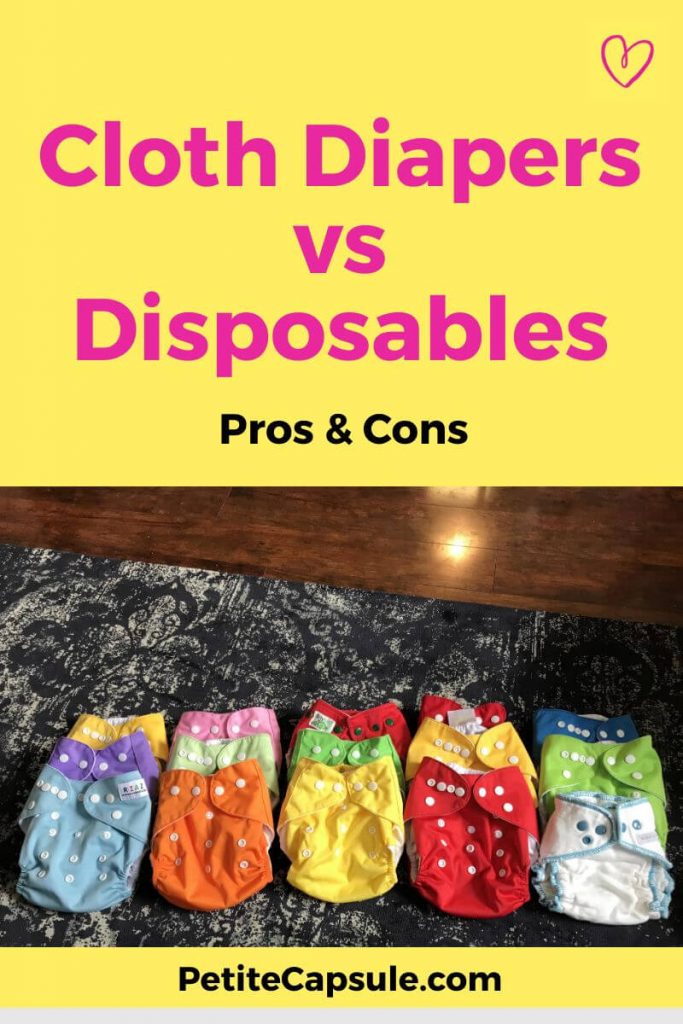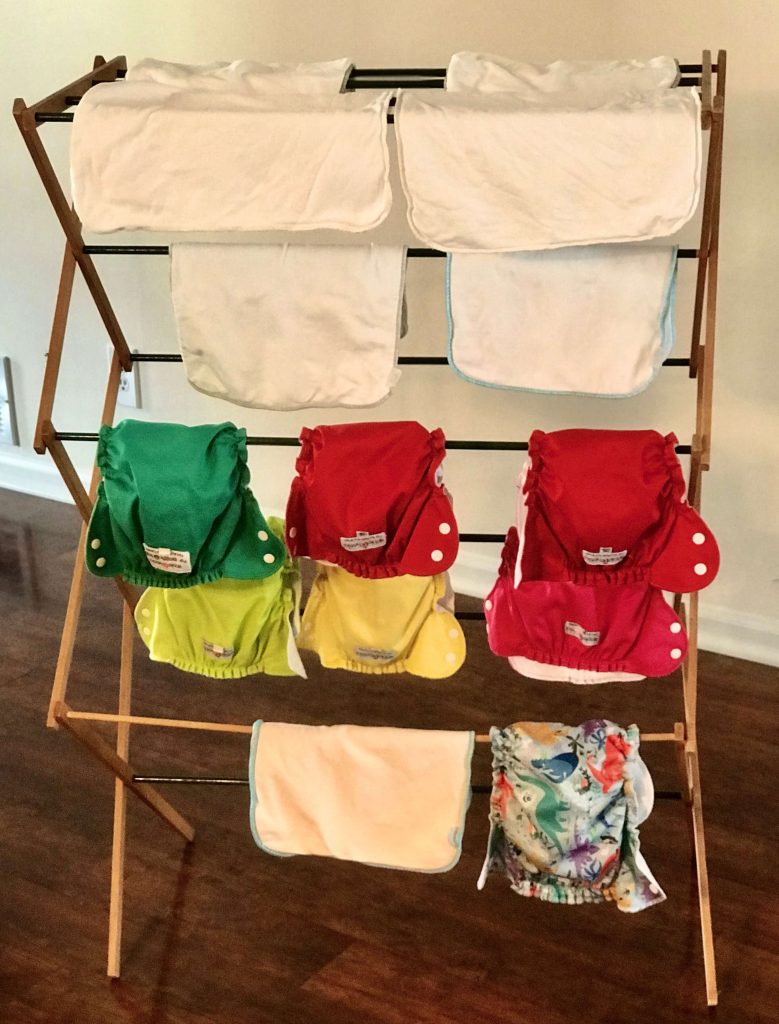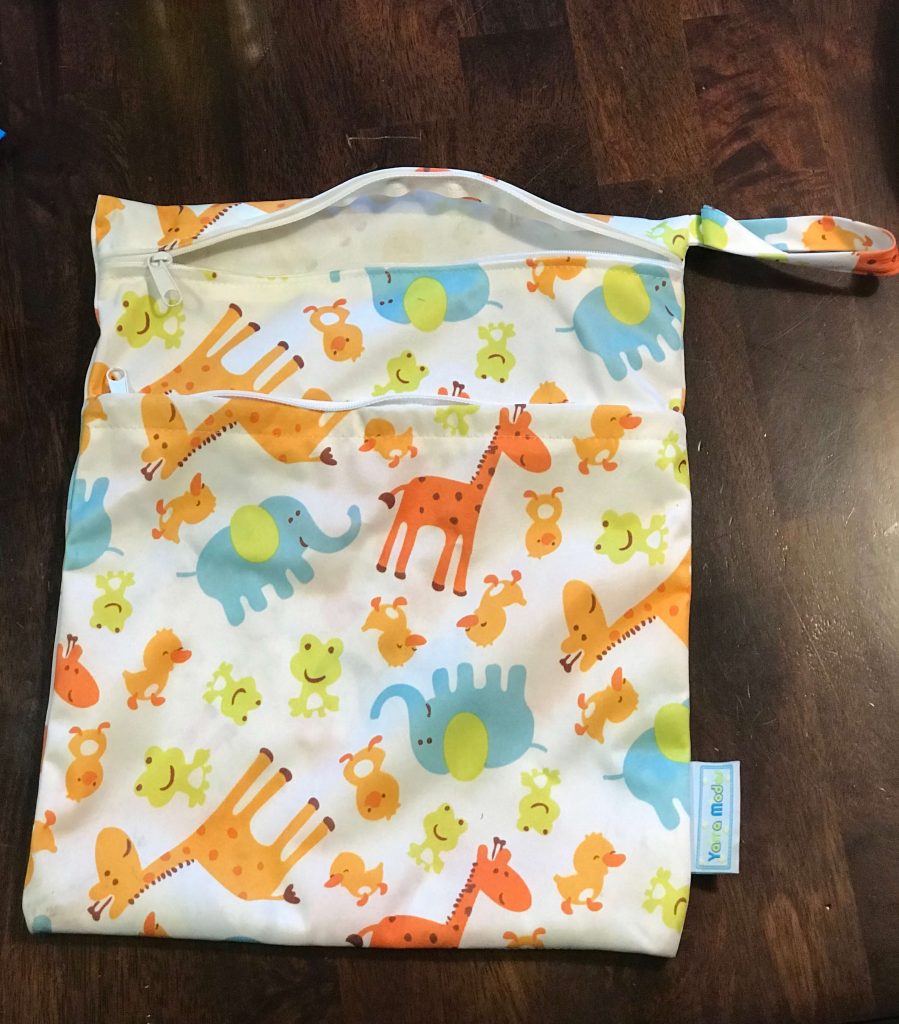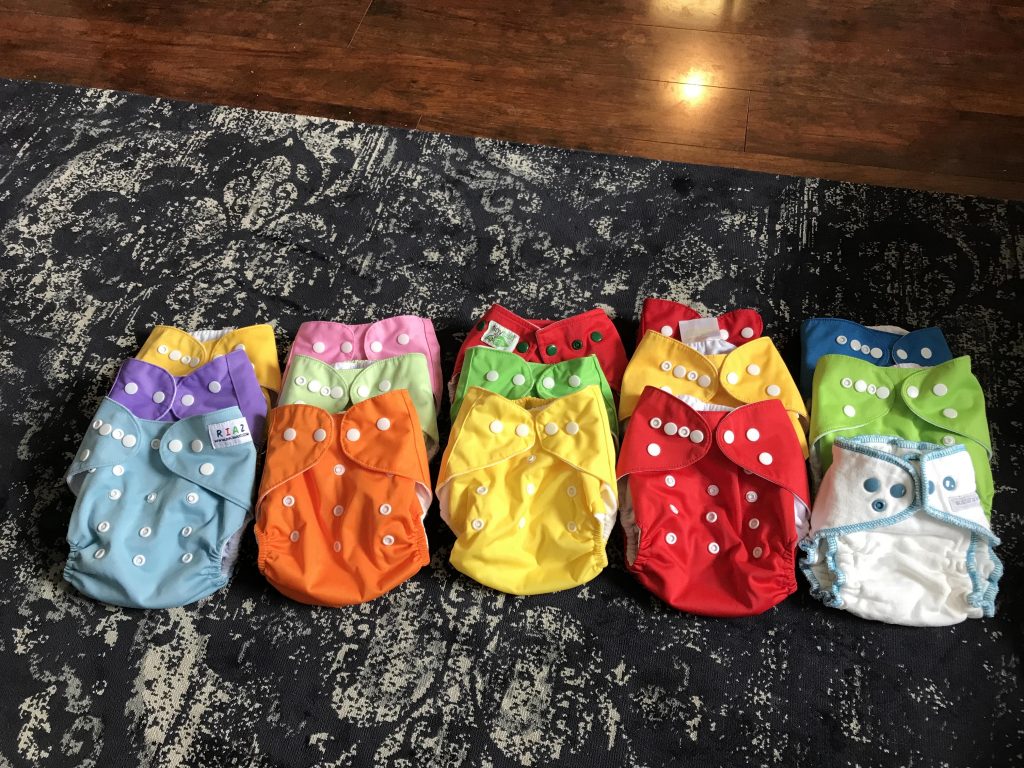Today I would like to introduce Emily, mum to three kids under six, and founder of The Crispy Family. Emily will be sharing cloth diapers pros and cons, and going through the whys and why nots of disposable vs cloth nappies.

Table of Contents
Cloth Diapers Pros and Cons
As a mom of three kids under the age of 6, I get my fair share of questions from expecting and new moms. Some want advice on feeding or sleep strategies. Others wonder about vaccination schedules and clothing choices. But one topic that has been in the spotlight lately is reusable cloth diapers! Many want to know if they really are worth all the hype. What about all of the laundry? What do you do when you go out somewhere?
Disposable vs Cloth Nappies
I have been a disposable diapering mama as well as a cloth diapering mama and found that each approach has benefits as well as drawbacks. So which is better?
Consideration: Cost
Winner – Cloth Diapers
When I broke it down, the math looked something like this. If a child wears Pampers disposable diapers until potty training is complete, on average, they will use 5500-6000 diapers. Here in the United States, Pampers cost $0.25 per diaper. Add those together to get the total cost of diapering a child in disposables.
5750 diapers x $0.25 = $1437.50
Keep in mind that number doesn’t include wipes that you would need to buy to go with those diapers as well! I think it would be a safe estimate of $2000 per child when using disposables only.
When it comes to the cost of cloth diapers, there can be a drastic variance depending on what type of cloth diaper you buy as well as if you purchase them new or secondhand. Taking a middle of the road example, an average cloth pocket diaper (shell only) can be purchased for around $12 each. You can also buy a 10 pack of new pre-fold inserts to go inside the diaper for $17 at our local Target. So if we do the same math, an average supply of 20 cloth diapers (enough for two days or so) new comes to
20 diapers x $12 = $240
If you add in the pre-folds inserts, 20 of those would cost you an additional $34, making your grand total for a nice beginner set of cloth diapers $274. And that’s buying them new. If you buy them secondhand from another mama, you can usually get a good sized set for $200 or so!
Additionally, most mamas who cloth diaper their babes choose to use cloth wipes instead of purchasing them from the store. It’s incredibly easy to make your own wipes and wipe solution, so there is little to no extra cost associated.
NOTE: I will say that 20 diapers is enough to start off with, but you will probably be doing a load of diaper laundry every night. Because of this, most mamas tend to grow their stash even more as they go.
As you can see above, when it comes to the money behind deciding whether to go cloth or disposable, cloth wins hands down. Not only does the initial investment pay for itself within the first few months, if you decide to have more kids in the future, you already have the diaper supply and there is no additional cost to you. However, if you’re done having kids, you can resell the diapers and recover some of the money you INVESTED in them. There always seem to be new mamas on the lookout for gently used diapers!
Consideration: The Laundry

Winner – It’s a TIE!
It’s no secret that choosing to cloth diaper a baby means more laundry. The diapers need to be put through a rinse cycle to get all the ick off first, then a full wash cycle to clean them. Most cloth diapers recommend being air dried, so at least you can shake that electric dryer. However, if you don’t already have a drying rack, you’ll need to get one. And you’ll need to expect to do one load of diaper laundry each day to keep on top of it.
So, how exactly is this a tie? Because of one of the biggest secrets cloth diapers keep: NO BLOWOUTS! Most cloth diapers have serious elastic around the legs AND the back of the diaper, so nothing escapes them. Seriously, I’ve cloth diapered two out of my three kids at least part-time and the breast-fed baby blowouts were awful in the disposables. No matter how tight I would get those diapers, we ruined so many adorable outfits with stains that just wouldn’t budge! So while we didn’t have extra diaper laundry, we had our fair share of poop or even pee laundry at least twice a week. Considering that some outfits needed to be stain-treated and washed again, I would say that for some kids, the laundry is almost less for cloth diapers!
Last note about laundry: If you are on the fence about buying diapers as well as freaked out about laundering them, look into diapering services near you. These businesses will provide diapers at your door as often as you would like as well as take away the soiled ones and launder them for you. You don’t have the investment of owning the diapers, and it can definitely have a price tag, but some mamas find it so much easier not to have to deal with the hassle while also avoiding disposables if you should wish!
Consideration: Portability
Winner – Disposables
This should come as no shock. When you choose to diaper in disposables, you have the amazing convenience of changing your baby and throwing away the soiled diapers in the nearest bathroom trash. Bye bye diaper – moving on!

When cloth diapering, outings and traveling aren’t so easy. To make it as easy as possible, the vast majority of cloth mamas recommend buying a wet bag. A wet bag is smell-proof, waterproof, and can clip onto diaper bags, strollers, etc. Putting the soiled cloth diapers in the wet bag will keep them from stinking up the restaurant, car, etc until you get home. You get the gist.
Additionally, another factor is the pure bulkiness of cloth. Cloth diapers, especially stuffed ones, don’t fit in a diaper bag as nice and flat as disposables. When we go out and baby is in cloth, I will bring two “diaper” bags. One for diapers and the wet bag and the other one for everything else I might need. It’s not ideal, I will admit. And traveling? Forget about it. Having to bring diapers, wet bags, laundry detergent, drying racks… Nope. Nope. Nope. Disposables are a runaway here.
Consideration: Daycare Requirements
Winner – Disposables
This is one of those factors that may or may not have weight in your decision, but it’s worth talking about. Unfortunately, it tends to be something that not a lot of expecting mamas think to ask about when searching for diapers OR daycares. Before I stayed at home with my kiddos, I had experiences with daycares that wanted nothing to do with cloth as well as daycares that were open to it, but didn’t really know what to do with them. I’m sure that as cloth diapers increase in popularity, we will see more daycares shifting to being cloth-friendly, but it is still something to think about. The majority of daycare providers are much more comfortable with disposables and would likely prefer them. Lastly, it’s easier to keep a stash of disposables at daycare than lug new cloth back and forth daily.
Consideration: Chemical Exposure

Winner – Cloth Diapers
Again, I feel like this should be no big surprise. The majority of cloth diapers are made of a breathable cotton fabric and lined on the outside with a waterproof shell. There are no absorbent gels or flame retardant chemicals that are found in many disposables. Many moms prefer this as some babies can have rashes or other skin reactions due to the chemicals found in disposables. Switching to the “Sensitive” versions of the brands is an option, but even these still contain their fair share of icky ingredients. If natural based products are important to you, cloth is the way to go.
Consideration: Absorbency
Winner – Disposables
This is probably the stickiest factor when it comes to choosing cloth or disposables. While not natural at all, those previously mentioned gels and additives found in disposables do serve a purpose. They make disposables much more absorbent than when compared to cloth diapers. While disposables need to be changed every 3-4 hours, cloth will need to be changed twice as frequently. 1.5-2 hours is really a good average.
Of course, times between changes do increase as baby grows, but cloth diapers won’t have the added moisture wicking technology that disposables have. Therefore, if not changed frequently enough, diaper rash could occur more often with cloth. To combat this, cloth mamas tend to stuff diapers with more inserts or even double-diaper for night time or naps.
Consideration: Diaper Rash
Winner – Disposables
As we started discussing in the last section, increased moisture sitting on the skin can cause cloth babies to have an increased risk of getting a diaper rash. Additionally, most diaper rash creams are not safe for use on cloth diapers as they will stain and/or alter the effectiveness of the diapers. There are cloth diaper safe creams out, but they tend to be more natural-based and a tad more pricey.
***Assuming the diaper rash comes from moisture and NOT from exposure to the chemicals on the diapers themselves, I chose to give disposables the credit here. However, I must reiterate – frequent changing of babies in cloth diapers have actually shown a decrease in overall rash appearance compared to suggested changing guidelines for disposables.***
Consideration: Potty Training
Winner – Cloth Diapers
Something that doesn’t get talked about a lot in the beginning of a diapering journey is how you will get the baby OUT of the diapers once they are toddlers. But from my personal experience, babies who are cloth diapered tend to potty train sooner. But why?
As previously stated, cloth diapers do not remove moisture as efficiently as disposables do, so babies will feel more uncomfortable in a wet or even dirty diaper as they get older. As they begin associating that cold feeling with voiding, they will start to follow their natural instincts to void in a potty instead of inside their diaper.
On average, cloth diapered babies show interest in potty training around 26-30 months vs disposable diapered babies who historically potty train closer to 34-36 months. And boy, what a difference those six months can make!
Consideration: Eco-Friendly Status
Winner – Cloth Diapers
Again, shocker, right? Research has shown that a single disposable diaper could take as long as 1000 years to decompose completely. 1000 YEARS!! That’s insane. My brain literally cannot comprehend that. If it takes that long for whatever is inside those diapers to disappear, do we really want it on our baby’s bum 24/7 for years?
Cloth diapers are an easy eco swap.
Final Verdict

Honestly, both cloth and disposable diapers hold significant ground as to why they should be the bum cover of choice. Cloth diapers have come a long way since disposables overtook them in popularity back in the 1960s. They are very similar in a lot of ways to disposables and while they solve problems, other problems arise that only disposables can fix.
My personal opinion and current diapering practice is one of a cloth/disposable diapering partnership. In truth, there’s room for every diaper under the sun in my home. We have multiple types of cloth diapers as well as disposables and they all get used.
My babes are 90% cloth diapered. If we are hanging out around the house or just going out for a quick dinner/running errands, we use cloth. I love the thought of being eco-friendly while saving money at the same time!
However, if we are going out for the day (think the zoo) or if they are heading to bed for the night, we put disposables on them. I’m not interested in the hassle of cloth when traveling or putting babies to sleep. I know some babies sleep all night in their cloth diapers. Unfortunately, my kids never did. They were very bothered by the wet diapers and would wake up multiple times. Once we started using disposables at night, their sleep improved dramatically. After five years, that is what we have found to work best for us.
So where does that leave us?
Ultimately, choosing your diapering preference is as personal as choosing bottle or breast. If you like to adhere to a strict budget and love the natural approach, go with cloth and feel good about your eco-conscious self!
On the other hand, if you feel drawn to the convenience and increased absorbency disposables can provide, diaper that baby in whatever brand you choose and be proud of it!
As a mama who has diapered three kids three different ways, I can tell you that there is no wrong time to change your mind if you aren’t happy. Don’t be afraid to switch it up. You might find that you want to use both and I think that’s a pretty cool option too.
Author Bio
Emily Seddon is a wife, mummy, friend, and blogger. She lives with her family in Nebraska and enjoys spending free time doing variety puzzles, watching Harry Potter for the zillionth time, and sending her kids outside to play. She’s the founder of The Crispy Family, where she writes about gentle parenting, family budgets, and easy DIY projects.
